-Рубрики
- Почтовые марки (17)
- Искусство+ (9)
- Архитектура+ (5)
- Digital art (13)
- Orienral art (60)
- Китайское искусство (15)
- Японское искусство (20)
- Useful (36)
- Афоризмы, Пословицы, Цитаты... (7)
- Время, часы (2)
- Изо-альбом (498)
- Айвазовский (39)
- Коллекция (37)
- Натюрморт (191)
- Пейзаж (187)
- Сюр (28)
- Фиалки (5)
- Фото (11)
- Шишкин (6)
- Истории (23)
- Оформление (205)
- Притчи (4)
- Религио+ (29)
- Софт+ (8)
-Цитатник
Автомобили в живописи //s020.radikal.ru/i722/1402/88/71e180daf464.jpg //s003.radikal.ru/i201/1...
Художник Занковский Илья Николаевич - (0)Художник Занковский Илья Николаевич (1832-1919) Горные пейзажи http://x-lines.ru/letters/i/c...
Мещерский Арсений Иванович - (0)РУССКИЕ ХУДОЖНИКИ Мещерский Арсений Иванович (1834-1902) Автор многочисленных самобытных пе...
Нури Якубов - крымскотатарский художник-живописец. - (0)Нури Якубов - крымскотатарский художник-живописец. Крым. Древние крымские улочки, сады, вино...
И.К. Айвазовский: зимние пейзажи прославленного мариниста - (0)И.К. Айвазовский: зимние пейзажи прославленного мариниста И.К. Айвазовский. Исаакиевский соб...
-Метки
-Приложения
 ОткрыткиПерерожденный каталог открыток на все случаи жизни
ОткрыткиПерерожденный каталог открыток на все случаи жизни Я - фотографПлагин для публикации фотографий в дневнике пользователя. Минимальные системные требования: Internet Explorer 6, Fire Fox 1.5, Opera 9.5, Safari 3.1.1 со включенным JavaScript. Возможно это будет рабо
Я - фотографПлагин для публикации фотографий в дневнике пользователя. Минимальные системные требования: Internet Explorer 6, Fire Fox 1.5, Opera 9.5, Safari 3.1.1 со включенным JavaScript. Возможно это будет рабо Яндекс Директ(контекстные рекламные объявления )
Яндекс Директ(контекстные рекламные объявления )
-Новости
-Я - фотограф
Соринка в глазу
-Поиск по дневнику
-Подписка по e-mail
-Интересы
-Друзья
-Постоянные читатели
-Сообщества
-Статистика
Старинные часы |
Старинные часы


-----------------АВТОМАТОНЫ-------------
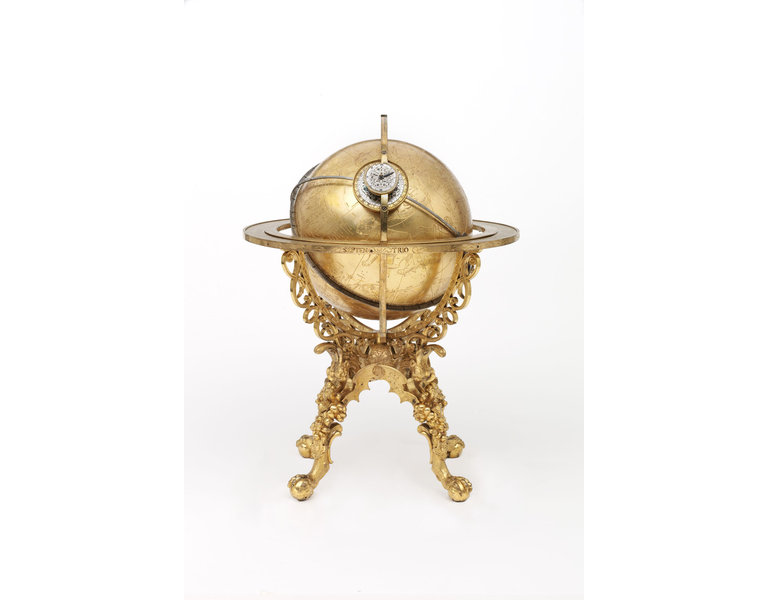
Mechanical globe clock
Place of origin:Augsburg (made)
Date:1584 (made)
Artist/Maker:Roll, Georg (maker)
Reinhold, Johannes (maker)
Materials and Techniques:Copper alloy, cast, engraved, punched and gilt
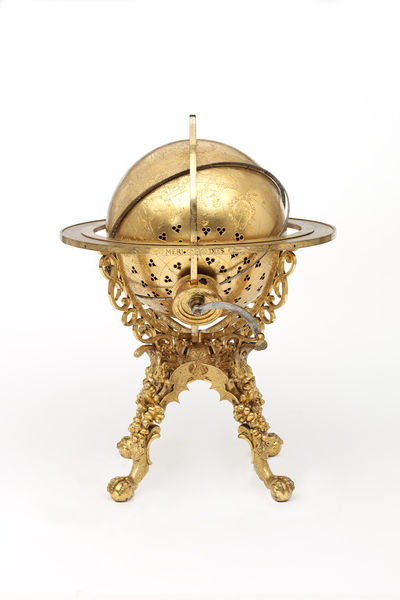
This mechanical clock was bought by the Emperor Rudolph II in 1584 and housed in the Imperial Treasury in Prague. The globe served as a model of the universe simulating the movements of the sun, the moon and the stars. It could predict the movements of celestial bodies at any time in the past and the future and could tell the time by the position of the stars.
-----------------------
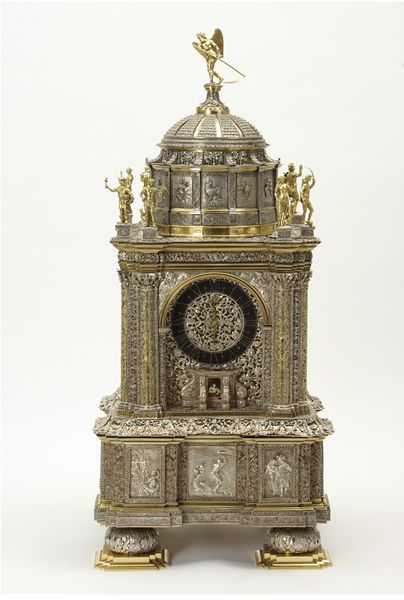
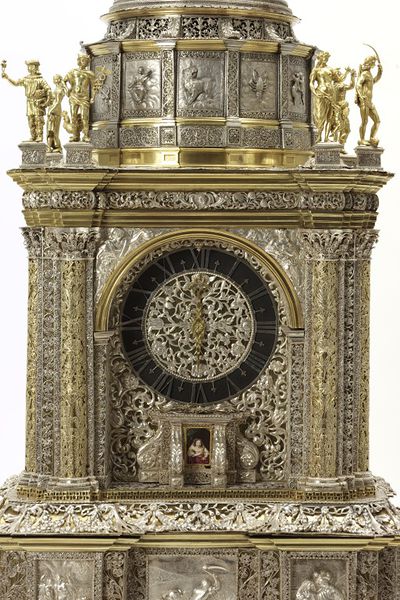
Clock
Place of origin:The Hague (made)
Date:ca. 1665-1670 (made)
Artist/Maker:Breghtel, Hans Conraedt (designer and maker)
van den Bergh, Adriaen (movement, maker)
Materials and Techniques:Silver and silver-gilt, pierced, embossed, filigree
-----------------------

Made in Poland
Date
1575-1585

Copper-gilt oval table clock; sides and base richly embossed and chased with formal scrolls and fruit; top engraved with delicate scrollwork and figures of man with pack and milkmaid and cow (automata); former holds staff and revolves in dial of which staff points out the hours.

---------------------------
----------------------------
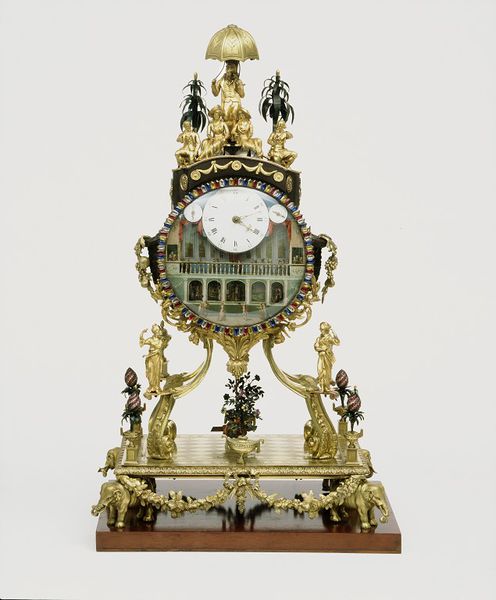
Automaton clock
Place of origin:London (made)
Date:ca. 1780 (made)
Artist/Maker:William Carpenter (maker)
Materials and Techniques:Clock case, mechanised figures and bells of gilt brass, with enamelled and glass paste decoration
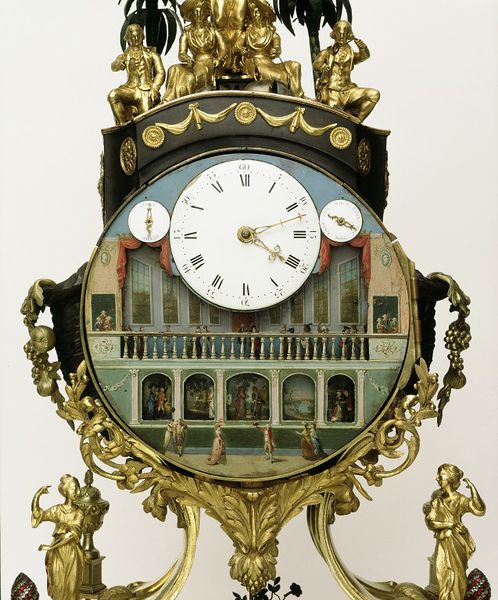
This musical clock by William Carpenter is typical of the kind of elaborate exotic time-piece made in London for export to the East in the late 18th century. Turkey, China and India were the principal destinations for these clocks.
-------------------------------

Antique French Empire ormolu automaton clock of the dog Barry.

Unusual French Empire automaton clock depicting the famous rescue of a young boy by Barrie. The dog died in 1814 and this clock is dated 1816. Very fine quality case with original fire/mercury gilding. 8 day bell striking movement with silk suspension. The automaton outside bell strikes on the hour and half.
-----------------


A very rare French Empire automaton carouselle clock in patinated bronze and ormolu by Vaillant a Paris. Of exceptional quality to casting and finishing and with its original mercury gilding and patination. The octagonal base with applied ormolu mounts of cupids blowing trumpets, ormolu busts of hypographs to the sides, griffins below the white enamel dial and cornucopia around the upper edge. A central stem rises upon a superb stepped base and connected to this are three ormolu figures of Mercury, Cupid and the Jester sitting upon swans that at each hour or at will by turning a lever at the back, that rotate around the central stem for several rotations and then stop. Circa 1805.
----------------------------------------

Часы-автоматон в виде паровоза с чернильницей. Бронза, перламутр
Palais Royal automaton cowtail Zapler clock in the form of an early 19th century steam locomotive as a desk set with inkwell and sander. The mother of pearl desk set with four ormolu feet beneath a tray made of panels of mother of pearl. The facet cut blue glass inkwell and sander with ormolu tops set in floral ormolu holders.

1830
--------------------

DIT LE PASSE ET AVENIR L` ", described as the one who knows the past and sign foretells the future." France, Diraectoire era circa 1795. Ziffbl.. "Vaillant à Paris" chased and gilt bronze. Eight Days works with anchor gear, thread suspension of the pendulum, beat on bells to full-and half hour on bell.
--------------------------

French Water Wheel Timepiece


This rare and extraordinary French eight-day timepiece celebrates the advances made in the industrial field in the 19th century. Almost certainly crafted by the famed A.R. Guilmet, this clock is finely constructed of silver and patinated brass, in a form resembling a brick mill or factory, atop a base of brass and red marble.
----------------------------

automaton picture clock. Set in a fine gilt frame with the painting protected by the original glass. The picture in oils on metal is of a harbour scene, very well painted. A ship with storm sails only can be seen tossing and bucking in the fierce seas. There is a clock in the church on the hill. There is an early musical movement operated by pulling a cord. The automaton movement is by Cailly and the movement in the church although having a miniature dial is a full sized movement signed by Hry Mark with a silk suspension and striking the hours and halves on a gong. French. Circa 1840 34

Automaton and musical picture clock by Cailly and Hnry Mark Paris
---------------------

antique automaton clock set of industrial steamhammer and rollers.

automata clock with inverted Y shaped form in patinated and gilded bronze . The platform to the left of the clock with silvered bronze operator linked via a mock steam whistle handle to the imitation vent and whistle on top of the case. The steam hammer rising and falling with the pendulum. The patinated bronze dial with Roman numerals and gilt hands. The 8 day movement rack striking on a bell. The compound pendulum linked to the steam hammer making it rise and fall. The candelabras conforming to the clock but are in the form of roller presses.
----------------------------Башни-автома


Strasbourg Clock
Inscription Content: ISAAC HABRECHT FABER AVTOMATA RIVS ET CIVIS ARGENTORATENSIS 1589
Carillon clock; weight-driven musical clock; originally controlled by balance wheel, movement converted to pendulum in 18thC; outer case of gilded brass, engraved with figures personifying the three theological virtues (Faith, Hope and Charity), the three worldly virtues (Wisdom, Fortitude and Justice) and the three fates of man on the back.
Height: 140 centimetres
Width: 38.5 centimetres
Depth: 38.5 centimetres

The Trustees of the British Museum.
-------------------
-----------------

Antique automaton industrial clock in form of lighthouse with rotating light
industrial clock with torsion pendulum which as well as regulating the clock's timekeeping moves the large lighthouse prism lamp from side to side as the pendulum beats. In the shape of a typical 19th century lighthouse with brick or stone blockwork with a broad base and tapering towards the top, having windows set in the column. The clock has a black marble base and the clock face is set as the lighthouse door. The top of the lighthouse has a gallery surrounding it. The clock is of 8 day duration and strikes the hours and halves on a bell. The clock has a gilt dial and blued steel hands. France circa 1890
-----------------------------------


Fine ormolu and red marble ormolu automata clock in the form of a Gothic well, based on a similar piece in the Wallace Collection. There is an 8 day timepiece movement below the well and a barometer below that. The case stands upon a shaped griotte marble base. The fine ormolu case exhibits corbels rising to peacock finials and to the top of the cupola, dolphins. To the sides are seamonsters cast in high relief. A separate movement drives the automata in the form of a twisting glass rod giving the appearance of flowing water. The cupola is held up by four beautiful columns in the form of palm trees. France circa 1880.
---------------------------ЧАСЫ-БАШНИ---

Viennese Silver & Lapis Conical Clock Tower Set constructed with immense complexity and unmatched artistry, this rare and incredible Viennese conical clock tower set is one of the finest examples of Austrian silver and enamel craftsmanship ever made.


1865
------------------------------


Considered to be the greatest sculptural clock ever made, this exceptional Régulateur Louis XV surmounté du Motif le Temps is the second of only six known to have been made by the master cabinetmaker François Linke. The result of a very successful collaboration between Linke and designer Léon Messagé, this clock was constructed especially for the 1904 St. Louis Exposition after the success of it predecessor, which was itself specifically created for the 1900 Paris Exposition Universelle. Standing over 10 feet tall, the magnificent inlaid tulipwood and fruitwood case is richly decorated in mythological and natural motifs rendered in cast bronze ormolu.


--------------------------

Brass cased clock in shape of lighthouse; time-keeping movement with going barrel and platform escapement with ratchet-tooth lever escapement mounted half way up the tower; second clock-work mechanism housed in base turns the faceted glass cylinder that houses the light.
1875-1885
----------------------БРОНЗА------------
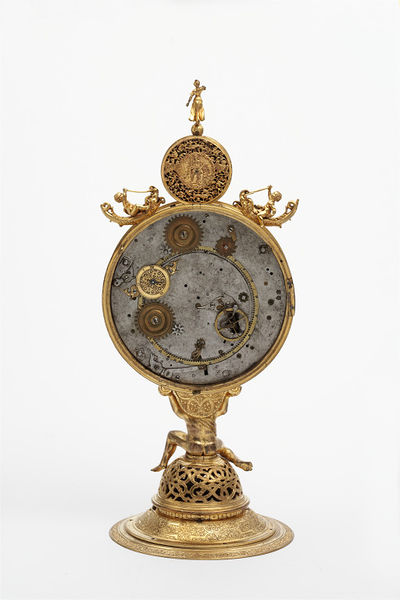
Clock
Place of origin:Augsburg (made)
Date:1564
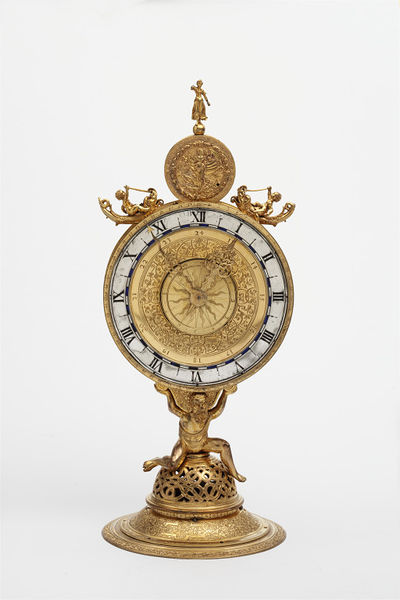
Clock
Place of origin:Augsburg (made)
Date:1564 (made)
Artist/Maker:Metzger, Jeremias (maker)
Materials and Techniques:Gilt brass with enamelled silver dial ring
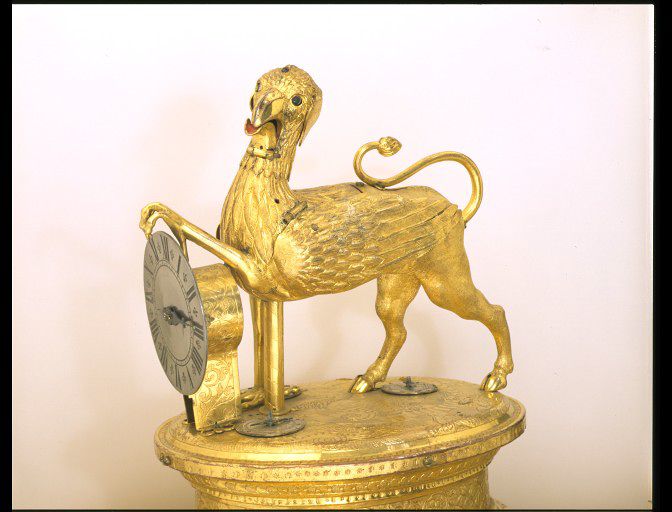

Francesco Righetti
Technique : Chiselled
Main material : Gilded bronze
Period of creation : 1810
Country of creation : Italy


Highly important and rare Italian neo-classical clock. Rome, circa 1810. Possibly after a design by Francesco Righetti. Francesco and Luigi Righetti, important goldsmiths, active at the end of the eighteen century in Rome
----------------------------------

- Vienna, circa 1810, the gilt bronze casing is held by four dolphins on a marble base and topped by an eagle. Marble pedestal with gilt ornaments on lion's feet, double pendulum in the form of horse carcasses.
----------------------------

Pendule au bon Sauvage - "Nègre nonsmoker. (probably Portrait of slave liberator Toussaint L'Ouverture, 1743-1803). Roller plaything: Capt. Henry (Geneva 1802-1811) with four different melodies. Bronze: attr. Pierre-Philippe Thomire (1751-1843). Paris to 1825th gilt, chased and patinated bronze.
--------------------------------

---------------------

Pendulum Clock "The chariots of Telemachus. Design and Bronze: attr. "Jean Andre kingdoms" (from 1752 to 1817). France, Empire era approximately 1800. Ziffbl sign .-. "Oudin eleve de Breguet. excellent composition with excellent gilt and patinated bronze eight-day movement with anchor gear, thread suspension of the pendulum strike on a bell to the full - and half an hour.
---------------

Pendulum Clock "The study of astronomy." Design and Bronze: attr. Claude Galle, 1807 France, age empire in 1810 and chased gilt bronze, marble vert-de-mer eight-day movement with anchor gear, thread suspension of the pendulum strike on a bell to the full - and half an hour.

Серия сообщений "Время, часы":
Часть 1 - Старинные часы
Часть 2 - Мы играем в жизнь, а время играет нами...
| Комментировать | « Пред. запись — К дневнику — След. запись » | Страницы: [1] [Новые] |









